The atmosphere, the surface of the planets
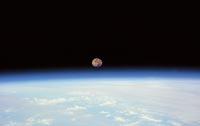
The Earth is surrounded by a gas cover. These gases have gone unturned: they are too light to be glued to the Earth's surface and too heavy to overcome the force of Earth's gravitation and leave open space. All these gases constitute an atmosphere.
However, observing the nearby planets, it is observed that not all have atmosphere. In general, a number of requirements must be met to have an atmosphere, but above all gravitational force is essential. Otherwise, temperature also has to do with pressure. A minimum temperature is required for molecules to be in a gaseous state and not in a liquid or solid state. Nor is too high a temperature recommended, as with this energy the gas can escape to a wide space. However, a planet can have atmosphere at very high temperatures if it has a lot of gravitational force.
Gas giants
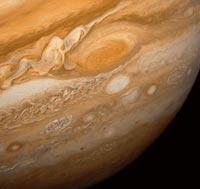
Look at Jupiter and other gaseous giants like Saturn, Uranus and Neptune. Its temperature is very high, but its gravitational force is even greater. It is so large that it is able to capture and retain the gases of the environment around the planets. In this way they took the measure that these planets have today, and that is why they are called gas giants, especially because they are colossal planets formed by gases. For example, the mass of Jupiter is 300 times that of Earth and the volume is 1,300 times greater.
It does not seem easy to distinguish the atmosphere on a planet formed by gases. In short, how to distinguish the gas layer of the area, which by definition is that atmosphere, if the planet itself is formed by gases? The truth is that these planets contain a small solid core, formed by metallic rocks and hydrogen, among others. Neptune's solid core, for example, is the size of the Earth, but if you take into account the atmosphere, Neptune is almost 60 times larger.
Despite the scarce solid character of the gas giants, their gas layer around the core is also very compact, with great pressure, and it has been determined that more than one layer of gas covering the planet is part of it.
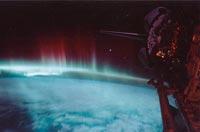
Despite the dense atmosphere, there is no movement. Just look at the movement of the clouds seen on the surface of Saturn or Jupiter. The presence of clouds in the atmosphere makes wind displacements – turbulence, etc. – easy to follow. On these planets, therefore, there is no lack of wind. And there are storms, Jupiter, for example, has a huge red spot that seems to be a cyclone. This cyclone cannot be compared to that of the Earth, which is not a week, but has lasted centuries. It was first observed in 1664 and, despite having suffered some incidents, it still remains.
Its composition is more like the Sun than the other planets. The main components are hydrogen and helium. Somehow, gas giants are stars without enough energy.
Floors
As can be seen, our planet (Earth) and its surroundings are very different and do not resemble these gaseous giants. Just look at the measurement: Mercury, Venus, Earth and Mars look like dwarfs along with those giants. In addition, they are basically solid, so they are called terrestrial planets. Being so different, the atmospheres are also very different.
Two types of planets are thus distinguished from the atmosphere, the gas giants and the terrestrial planets. The reason for this difference depends on the birth of the solar system. Some 4.5 billion years ago the planets emerged: The small, solid earth planets closest to the Sun, and the giant gaseous planets grew further away with remnants of gases.

On the planets the heavier elements ‘fell’ towards the center and on them the rest were stacked, depending on their weight. The newborn planet was defining its atmosphere through three processes: volcanoes released carbon dioxide and water vapor, some materials evaporated and occasional meteorites brought new compounds. Although the processes were similar on all planets, the consequences were different. The mass of each planet and its proximity to the Sun were decisive.
Some of those early planets resisted the atmosphere and others did not. The smaller planets were harder to maintain the atmosphere: Mercury and Mars. Currently, Mercury has no atmosphere and that of Mars is very thin.
Mercury is the smallest of the terrestrial planets, with a mass eighteen times smaller than the Earth, and the closest to the Sun. Observations made from Earth and through the spacecraft Mariner 10 have shown no indication of a visible atmosphere. On the surface five elements have been found (oxygen, hydrogen, neon, sodium and potassium) but they do not form an atmosphere, but a thin layer called the exosphere.
Mercury is too small to have atmosphere. But it also has another reason for not having an atmosphere: It is very close to the Sun and the solar wind drags the gas marks. In fact, the Sun emits charged particles in all directions, as a wind blow.
Mars is also relatively small: It is almost twice as much as Mercury, but nine times less than Earth. In the photographs taken to Mars the surface is appreciated, so the atmosphere is almost transparent (hardly appear clouds or similar). According to experts, it was also a fact that contributed to the atmosphere not being stronger: the impact of a great object. It is believed that this impact caused a large part of the initial atmosphere into space, favoured by the solar wind and small gravity. But, as we have said, they are suspicions.
Venus dir-dir
The other two planets, Earth and Venus, are larger and have atmosphere. The solar wind reaches Venus more strongly than the Earth, as it is the closest planet to the Sun after Mercury. However, it is able to maintain the gaseous layer that surrounds it. Its atmosphere is very compact—it is not possible to see the surface of Venus seen from Earth—it is mostly made up of carbon dioxide, and the surface pressure of this planet is very high, about 90 times greater than that of Earth—no wonder that the probes buried there have survived only a few hours before the pressures are destroyed.
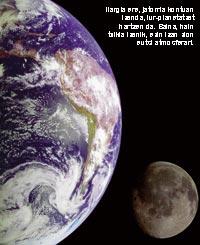
But what has aroused the curiosity of astronomers is another characteristic of the atmosphere of Venus: the atmosphere rotates faster than the planet itself. The rotation period of Venus is 243 days and the atmosphere of 4 days
In fact, in the absence of wind, the atmosphere should rotate at the same speed as the planet. But in the atmosphere of Venus a lot of energy accumulates. This energy comes from the Sun: the concentration of carbon dioxide in the atmosphere is very high and energy is accumulated through the greenhouse effect in the clouds of the atmosphere.
This dense atmosphere, in addition to accumulating the energy of the Sun, also reflects it, and therefore looks so bright Venus. It is the most visible planet from Earth thanks to its atmosphere.
However, this dense atmosphere of Venus does not fully protect from the solar wind, and charged particles (ions) seem to produce continuous auroras. The light of the aurora occurs when the molecules of the atmosphere, after being excited by the ions, recover. To completely protect itself from the flow of ions, Venus would need a powerful magnetosphere, a powerful magnetic field.
The magnetosphere, by itself, is spherical, but, due to the solar wind, it acquires a drop shape (the face facing the Sun is flat and lengthens on the opposite side). However, the presence of the magnetosphere is not enough to cope with the solar wind, since it has ‘weak points’.

Terrestrial auroras are an example of this: auroras are seen in polar areas and it is no coincidence. In the territories where the vertices of the Earth's axis of rotation would be, the magnetosphere is weaker and the solar wind is more penetrating in the atmosphere. Actually auroras are constant, but only the most intense are visible to human eyes.
Being a similar origin and measure, the atmospheres of Earth and Venus should be more similar — something is said to be the sister of Earth. But, as is known, the composition is very different. The main components of the Earth's atmosphere are nitrogen and oxygen, and Venus's carbon dioxide. Apparently, the evolution of the Earth's atmosphere was very different. We do not know exactly how that evolution was, but all indications point to that in the center of the salsa there are living beings. In short, it is a consequence of an uninterrupted evolution.
Remote atmospheres
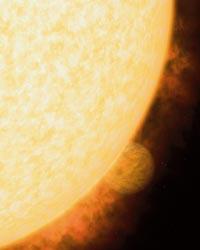
Most of the planets and satellites in our Solar System have been observed directly to determine if they have atmosphere, but with which they are far away the work is more complicated. In the case of Pluto, for example, being so small, one may think that it has no atmosphere. Nitrogen, methane and carbon monoxide have been detected on the surface of Pluto, but they are frozen when they are away from the Sun, because the temperature is very cold (-220°C). However, as we approach the Sun the temperature increases and these compounds may become gases and form a fine atmosphere.
Pluto's atmosphere structure and temperature were determined in 1988, when it passed by the Sun. And to know the atmosphere of extrasolar planets, exoplanets, the passage in front of a star is also used. It picks up how the light that comes from that star changes and compares with that which is received when it does not have a planet in front. By filtering the light of the star into the atmosphere of the exoplanet, spectroscopy identifies the components of the atmosphere.

Not long ago, in 2001, an atmosphere was first discovered on a planet outside our solar system. It belongs to an exoplanet of the constellation of Pegasus (HD 209458b), located 150 light years from Earth. The Hubble space telescope was used for this purpose. And it was not a slow advance, considering that the first exoplanet was detected a few years earlier (1995), a planet orbiting around a sun-like star.
Exoplaneta took advantage of a specific event to detect its atmosphere: It passed between the Earth and the orbiting star. And so, the light emitted by the star passed through the atmosphere of the exoplanet. Thanks to him it was concluded that he was a gas giant.





